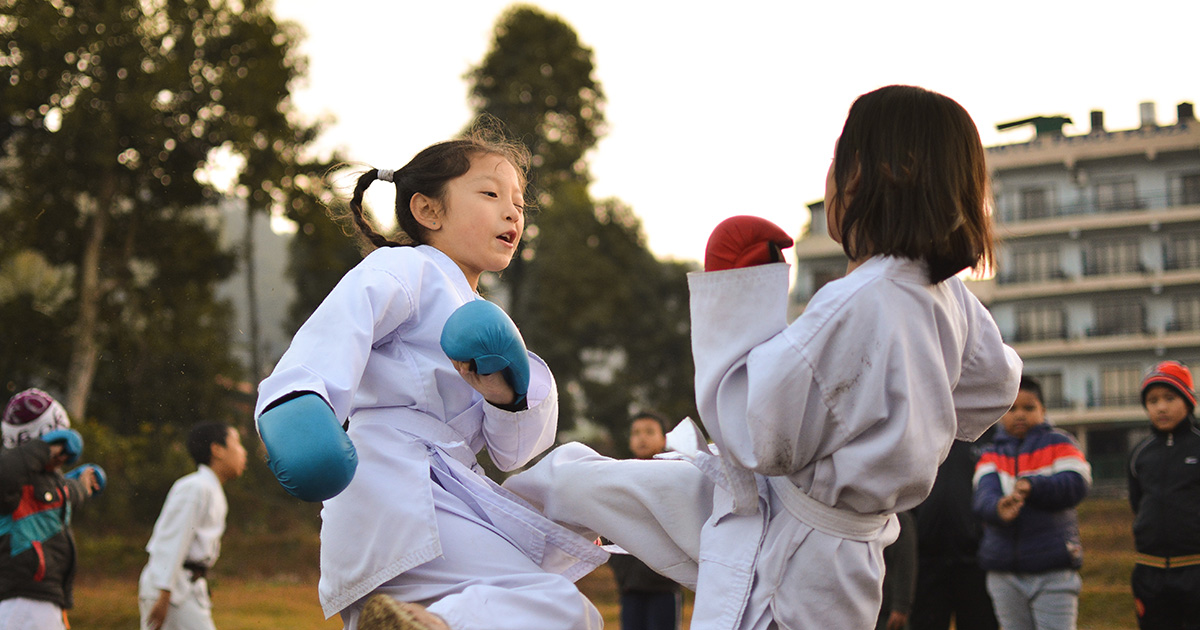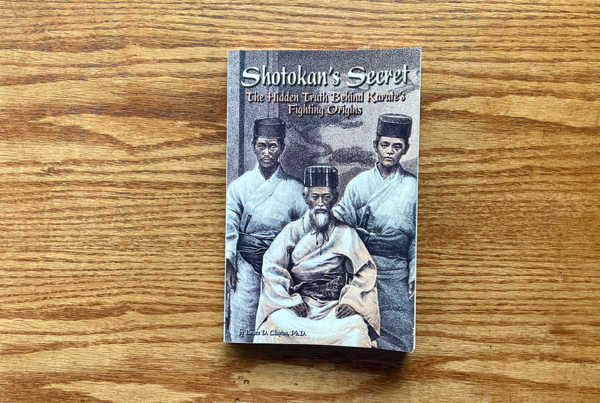Congratulations!
You (or your student) have decided to enter your first martial arts tournament.
Now, you’ll need to line up exactly what gear you’ll need to compete.
We’ll look at four of the most common events featured at martial arts tournaments:
- Forms
- Sparring
- Weapons
- Breaking
Note: This guide is a suggested list—Please review your specific competition’s rules to understand exactly what you’ll need.
Gear Needed For Forms
Uniform & Belt
The most basic elements with which to compete are your uniform and your belt.
Arguably, your belt is the most important of the two pieces because it signifies rank.
Tournament organizers use your age, gender, and rank to group you into similar divisions so you have a fair chance during the competition.
Whether you’re competing in forms or multiple events, your uniform and belt will be used for any event in which you compete.
Gear Needed For Sparring
All of the gear listed below is intended to reduce injury during a fair competition.
Tournaments are usually not as intense as The Karate Kid.

Even so, any tournament promoter will have you sign a waiver acknowledging that you understand there are risks associated with two people attempting to score punches and kicks on an opponent.
The risk for injury is significantly lessened by the rules promoters put in place around scoring and keeping athletes safe.
The following items are listed in most rule sheets as required equipment for sparring competitions.
Headgear
Every tournament I’ve run across requires headgear, a padded helmet that is strapped underneath the chin.
Some headgear also includes a face mask to protect against eye gouges and other cuts to the face and head area.
Their logic is that headgear prevents cuts and traumatic brain injuries.
Jason Thalken, Ph.D., suggests in his book, Fight Like A Physicist, that today’s headgear doesn’t do enough, even going so far as to put forward evidence that headgear with face masks increases, not decreases, your risk for TBI.
For that reason, I’d recommend wearing the helmet only without the mask.
Gloves Or Other Fist Protection
Padded gloves can help lessen the effects of punches to the body—some tournaments forbid punching to the head, especially those following taekwondo rules.
Standard gloves wrap around your wrists and have grips for your fingers that allow you to keep your gloves on during the match.
Boots Or Other Foot Protection
Like gloves, foot protection padding helps lessen the effect of a bony instep to the stomach or chest.
They have holds along the bottom and straps that wrap around your feet and ankles that usually keep them on, but sometimes, they slip off because fights are messy.
Cloth Shinguards
Many tournaments require cloth shin and instep guards nowadays, but that hasn’t always been the case.
I always recommend wearing shin and instep guards regardless of whether it’s required—almost 20 years later, I still remember the pain from the first time I clashed shins with someone as we threw simultaneous roundhouse kicks.
It takes a little extra care to wear the boots over the guards, but the protection is worth it, in my opinion.
Chest Protector
I’ve found many tournaments run by taekwondo schools either suggest or require chest protection.
I think it’s a wise move as it offers another layer of protection for the athlete, even if it takes away a little mobility.
Make sure you can find someone you trust to put your protector on for you as they’re nearly impossible to tie yourself.
Mouthguard
Sparring competitions usually require mouthguards to protect your teeth.
The specific type of mouthguard you or your child pick will depend on…
- Age: There are youth and adult mouthguard sizes.
- Braces: Special mouthguards account for braces. You may also want to consult your dentist on which mouthguard they recommend.
- Comfort & protection level: Manufacturers make mouthguards that fit either the top row of teeth only, or both the bottom and top rows. I prefer the mouthguard that fits only the top row. The mouthguard that fits both rows offers a space for you to breathe, but I think it’s uncomfortable. That type of mouthguard also makes it more difficult to talk, in case the center judge asks you a question.
Properly fit the mouthguard to you or your student prior to event day—manufacturers include instructions that say to perform some combination of dipping the mouthguard in boiling water, dipping it in lukewarm water for a second, and then fitting it to your teeth from there.
It’s an easy process that takes less than five minutes prior to event day.
For Boys and Men: Athletic Supporter & Cup
Males are usually asked to wear a cup for protection.
Kicks to the groin are legal in some tournaments.
Even when they’re not, athletes don’t always get their kicks above the belt level.
Males should include cups in their tournament checklist.
For Girls and Females: Chest Protector and Groin Protector (OPTIONAL)
Manufacturers also make groin and chest protectors specifically for females.
I’m not aware of any students who have used these, so I can’t speak to their effectiveness or comfort, but those options exist.
Bonus Tip #1: Practice In Your Gear
This might go without saying, but I’ll say it anyway: practice with all your gear on before tournament day.
If you’re a male who hasn’t worn a cup that much, wear your cup to practice (you always should anyway).
If you’ve never worn all of your gear before, wear it before your step in the ring on competition day.
The gear adds extra weight, you might throw your techniques differently, and the chest protector can feel like you’re gasping for air if you’ve never worn one before.
Don’t wait until tournament day to know how you move in your gear.
Bonus Tip #2: Bring Wipes To Clean Your Gear After Your Event Finishes
It’s a good idea to bring a container of sanitizing wipes for your gear to wipe them down the competition.
Gear could be soiled with any combination of dirt, blood, sweat, tears, spit, spilled concessions, or anything else going in and out of the venue that day.
Gear Needed For Weapons
Pay attention to the rules specific to the tournament you’re attending to understand what weapon you will use and how you can use it.
I won’t delve into all of the types of weapons you can compete with.
It would be good to bring not only the weapon, but a specific carrying case for it, as well—manufacturers make cases specifically for the bo, kama, sai, and katana, to name a few.
One suggestion I’d have, though, is to ask around to see whether it’s required that judges inspect the weapon.
This is often a sign of courtesy shown to the judges who may be weapons connoisseurs, but I’ve also heard of negative experiences in which judges actually broke the competitor’s weapon upon inspection prior to competing, leaving a competitor to scramble to find a suitable replacement at the last second.
Check at the event whether this formality is required before your division is up, if possible.
Gear Needed For Breaking
Generally, you’ll be responsible for providing your own breaking equipment and holders.
- Breaking materials – Again, check your competition’s rules, but generally, wooden boards are the most common type of material for competition.
- Holders & spacers – You’ll have choreographed a breaking sequence using your equipment. Bring those to ensure conditions are nearly identical at the event to which you have practiced.
- Volunteer holders – You may need to recruit volunteers at the event to help assist you. Work with your instructor to do so. Usually, a group of volunteers is near the breaking competition ready to help students hold their boards. You’ll need to instruct volunteers how to hold your board for your break, but they generally know how to help you accomplish your break.
One Final Piece: Martial Arts Shoes
I don’t know whether they’re legal or not, but I recommend wearing martial arts shoes during comeptition if possible.
A few weeks after a tournament I competed at (barefoot), I noticed a growth underneath my right middle toe that shot pain through the bottom of my foot if I stepped wrong.
I thought it was a callous, but it turned out to be a wart that stayed on my foot for about six months.
If you’re unable to wear martial arts shoes on the mat for any reason, I’d recommend wearing your regular shoes until it’s time to compete, and then using an antibacterial wipe before putting your shoes back on when you’re done.
And that’s it!
Again, consult your tournament’s official rules for specifics on what you’ll need since this list is merely a suggestion.
And remember: practice, practice, practice!
“What’s tournament day like,” you ask? Get prepared by reading this special guide just for you!
A Note About Equipment Purchases
If you’re one of my students (or parents), please discuss purchasing your equipment with me.
I realize you have options for shopping.
But, all purchases made through me will cost you the same as going through a martial arts supplier, and a portion of your purchase stays with Metamora Martial Arts to support what we’re doing.
Photo by Jyotirmoy Gupta on Unsplash




